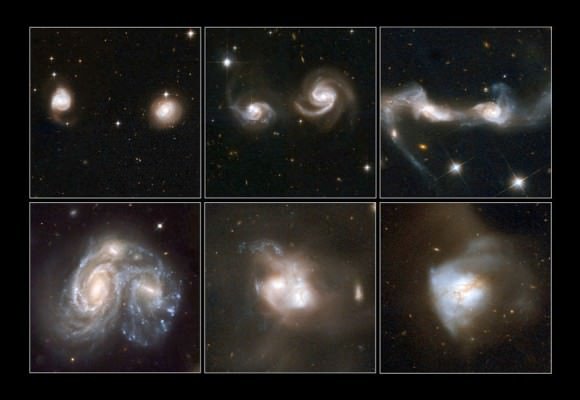Introduction
In the cosmic tapestry, galaxies stand as sprawling structures hosting stars, planetary systems, and a plethora of celestial phenomena. Among them, the Milky Way serves as our cosmic residence. Yet, our galaxy is part of a broader cosmic neighborhood, and the closest galaxy to the Milky Way is the Andromeda Galaxy (M31). The following article dives into the intricacies of Andromeda, elucidating its similarities and differences with the Milky Way and exploring the long-term gravitational relationship between these neighboring galaxies.
The Proximity of the Andromeda Galaxy
When discussing the term “proximity,” we usually refer to the nearness of one object to another. In the case of the closest galaxy to the Milky Way, Andromeda, we refer to its relative distance from our home galaxy.
How Far is the Andromeda Galaxy?
In astronomical terms, the Andromeda Galaxy is indeed the closest galaxy to the Milky Way. It is situated approximately 2.537 million light-years away from Earth. Though extraordinarily distant by human standards—considering that one light-year equates to about 5.88 trillion miles (9.46 trillion kilometers)—Andromeda’s distance is relatively small on a cosmic scale, particularly when compared to the vast intergalactic stretches.
Contextualizing the Cosmic Distance to the Closest Galaxy to the Milky Way
In the realm of astronomy, the concept of “closeness” diverges significantly from everyday human experience. To make sense of these immense distances, we employ light-years as a unit of measurement. The nearest star to Earth, Proxima Centauri, is about 4.24 light-years away, while the diameter of the Milky Way spans roughly 100,000 light-years. Compared to these metrics, the 2.537 million light-year distance to the closest galaxy to the Milky Way—Andromeda—becomes surprisingly “close.”
The Scientific Significance of the Closest Galaxy to the Milky Way
Andromeda’s relative proximity offers a unique window for astronomical observation and study. Being the closest galaxy to the Milky Way, it affords astronomers the opportunity to capture more detailed data and images than would be possible with more remote galaxies. As technology continues to advance, the proximity of the Andromeda Galaxy will facilitate increasingly nuanced studies, enriching our broader understanding of cosmic structures and behaviors.
Future Implications of the Proximity of the Closest Galaxy to the Milky Way
Andromeda’s closeness to the Milky Way isn’t merely an intriguing astronomical fact; it has profound future implications. The two galaxies are gravitationally bound for a colossal collision. Predictions suggest that in roughly 4.5 billion years, the Andromeda Galaxy and the Milky Way itself will merge, possibly forming a new elliptical galaxy. This event will indelibly alter the structural integrity of both galaxies.
Future Implications: The Great Collision
Andromeda’s proximity to the Milky Way isn’t just an interesting fact; it has serious long-term implications. The two galaxies are on a collision course, with their mutual gravitational attraction pulling them closer together. Predictions suggest that in about 4.5 billion years, they will collide and merge into a new galaxy, which could be an elliptical galaxy. This galactic merger will be a significant event in the lifetimes of both galaxies and could drastically change their current structures.
Physical Characteristics
Closest Galaxy to the Milky Way is estimated to contain one trillion stars, roughly twice the number in the Milky Way, and spans about 220,000 light-years in diameter. Despite its size, Andromeda and the Milky Way are similar in several ways. Both are spiral galaxies, possessing a flat, rotating disk of stars and gas, a central bulge, and spiral arms. These structural similarities have made Andromeda an object of particular interest as it provides a comparative model for understanding the Milky Way.
Is Andromeda bigger than Milky Way?
Yes, the Andromeda Galaxy is generally considered to be larger than the Milky Way Galaxy in terms of both mass and diameter.
In terms of mass, recent estimates suggest that Andromeda has a mass roughly 1.5 to 2 times that of the Milky Way. These estimates are based on various observational data, including the dynamics of its satellite galaxies, the velocities of stars in the galaxy, and the distribution of dark matter. However, it’s essential to note that these estimates have uncertainties, and the mass ratio could change as more precise measurements become available.
In terms of diameter, closest galaxy to the Milky Way also exceeds the Milky Way. It has an estimated diameter of about 220,000 light-years, whereas the Milky Way has a diameter that ranges from about 100,000 to 160,000 light-years depending on how one measures the galaxy’s extents, including its diffuse outer halo.
How Long Would it Take to Reach the Andromeda Galaxy?
If we consider a hypothetical journey to the closest galaxy to the Milky Way, the Andromeda Galaxy, using current technology, the timeframe is staggering. The fastest human-made spacecraft, the Parker Solar Probe, travels at speeds of about 430,000 miles per hour. Even at this pace, it would take an estimated 6.9 billion years to reach Andromeda. While theoretical advancements like warp drives suggest faster travel, these concepts remain speculative and far from actualization.
Composition and Stellar Population of the Closest Galaxy to the Milky Way
The Andromeda Galaxy exhibits a fascinating contrast to the Milky Way in its stellar populations. The halo of the closest galaxy to the Milky Way contains a higher proportion of metal-poor stars, offering insights into the divergent paths these galaxies have traversed through cosmic history.
A Future Cosmic Collision with the Closest Galaxy to the Milky Way
One inevitable aspect of being the closest galaxy to the Milky Way is that Andromeda is on a collision course with our galaxy. Predicted to occur in about 4.5 billion years, this event will significantly alter the structures of both galaxies, likely resulting in a new elliptical galaxy.
Examining the Closest Galaxy to the Milky Way
The proximity of the Andromeda Galaxy has been a boon for astronomical study. Advancements in telescopic technology, from Edwin Hubble’s initial observations to modern initiatives like the Panchromatic Hubble Andromeda Treasury (PHAT), have deepened our understanding of both Andromeda and broader galactic phenomena.

Socio-Cultural Implications of the Closest Galaxy to the Milky Way
The impending collision between the Milky Way and its closest galaxy, Andromeda, transcends scientific discourse and seeps into sociocultural conversations. The event serves as a catalyst for contemplating existential questions about humanity’s place within the universe and the scientific strides that might allow future generations to navigate such significant cosmic changes.
Conclusion: The Closest Galaxy to the Milky Way as a Cosmic Yardstick
The Andromeda Galaxy, being the closest spiral galaxy to the Milky Way, serves as both a cosmic mirror and a yardstick for understanding galactic phenomena. Its proximity allows for detailed studies that deepen our comprehension of galaxies, cosmic evolution, and perhaps even the future of our own galaxy. The relationship between Andromeda Galaxy and the Milky Way is a complex tapestry of kinship and destiny, spanning both distance and time, and is continually being enriched by new scientific discoveries.





